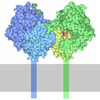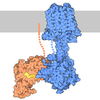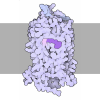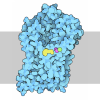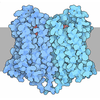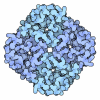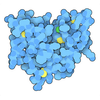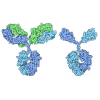[English] 日本語
 Yorodumi
Yorodumi- PDB-7f6g: Cryo-EM structure of human angiotensin receptor AT1R in complex G... -
+ Open data
Open data
- Basic information
Basic information
| Entry | Database: PDB / ID: 7f6g | |||||||||||||||||||||||||||
|---|---|---|---|---|---|---|---|---|---|---|---|---|---|---|---|---|---|---|---|---|---|---|---|---|---|---|---|---|
| Title | Cryo-EM structure of human angiotensin receptor AT1R in complex Gq proteins and Sar1-AngII | |||||||||||||||||||||||||||
 Components Components |
| |||||||||||||||||||||||||||
 Keywords Keywords | MEMBRANE PROTEIN / GPCR / angiotensin receptor | |||||||||||||||||||||||||||
| Function / homology |  Function and homology information Function and homology informationFatty Acids bound to GPR40 (FFAR1) regulate insulin secretion / Acetylcholine regulates insulin secretion / phospholipase C-activating G protein-coupled glutamate receptor signaling pathway / PLC beta mediated events / phospholipase C-activating serotonin receptor signaling pathway / entrainment of circadian clock / regulation of platelet activation / regulation of canonical Wnt signaling pathway / glutamate receptor signaling pathway / phototransduction, visible light ...Fatty Acids bound to GPR40 (FFAR1) regulate insulin secretion / Acetylcholine regulates insulin secretion / phospholipase C-activating G protein-coupled glutamate receptor signaling pathway / PLC beta mediated events / phospholipase C-activating serotonin receptor signaling pathway / entrainment of circadian clock / regulation of platelet activation / regulation of canonical Wnt signaling pathway / glutamate receptor signaling pathway / phototransduction, visible light / photoreceptor outer segment / neuropeptide signaling pathway / postsynaptic cytosol / response to prostaglandin E / enzyme regulator activity / GTPase activator activity / Turbulent (oscillatory, disturbed) flow shear stress activates signaling by PIEZO1 and integrins in endothelial cells / G protein-coupled receptor binding / G-protein beta/gamma-subunit complex binding / Olfactory Signaling Pathway / Activation of the phototransduction cascade / G beta:gamma signalling through PLC beta / Presynaptic function of Kainate receptors / Thromboxane signalling through TP receptor / G protein-coupled acetylcholine receptor signaling pathway / G-protein activation / adenylate cyclase-activating G protein-coupled receptor signaling pathway / Activation of G protein gated Potassium channels / Inhibition of voltage gated Ca2+ channels via Gbeta/gamma subunits / Prostacyclin signalling through prostacyclin receptor / G beta:gamma signalling through CDC42 / Glucagon signaling in metabolic regulation / G beta:gamma signalling through BTK / Synthesis, secretion, and inactivation of Glucagon-like Peptide-1 (GLP-1) / ADP signalling through P2Y purinoceptor 12 / photoreceptor disc membrane / Sensory perception of sweet, bitter, and umami (glutamate) taste / blood coagulation / Glucagon-type ligand receptors / Adrenaline,noradrenaline inhibits insulin secretion / Vasopressin regulates renal water homeostasis via Aquaporins / Glucagon-like Peptide-1 (GLP1) regulates insulin secretion / G alpha (z) signalling events / cellular response to catecholamine stimulus / ADP signalling through P2Y purinoceptor 1 / ADORA2B mediated anti-inflammatory cytokines production / G beta:gamma signalling through PI3Kgamma / Cooperation of PDCL (PhLP1) and TRiC/CCT in G-protein beta folding / adenylate cyclase-activating dopamine receptor signaling pathway / GPER1 signaling / Inactivation, recovery and regulation of the phototransduction cascade / cellular response to prostaglandin E stimulus / G-protein beta-subunit binding / heterotrimeric G-protein complex / G alpha (12/13) signalling events / sensory perception of taste / extracellular vesicle / signaling receptor complex adaptor activity / Thrombin signalling through proteinase activated receptors (PARs) / retina development in camera-type eye / G protein activity / GTPase binding / Ca2+ pathway / fibroblast proliferation / High laminar flow shear stress activates signaling by PIEZO1 and PECAM1:CDH5:KDR in endothelial cells / G alpha (i) signalling events / nuclear membrane / G alpha (s) signalling events / phospholipase C-activating G protein-coupled receptor signaling pathway / G alpha (q) signalling events / Hydrolases; Acting on acid anhydrides; Acting on GTP to facilitate cellular and subcellular movement / Ras protein signal transduction / Extra-nuclear estrogen signaling / cell population proliferation / protein stabilization / G protein-coupled receptor signaling pathway / lysosomal membrane / GTPase activity / synapse / GTP binding / protein-containing complex binding / Golgi apparatus / signal transduction / extracellular exosome / metal ion binding / membrane / plasma membrane / cytosol / cytoplasm Similarity search - Function | |||||||||||||||||||||||||||
| Biological species |  Homo sapiens (human) Homo sapiens (human) | |||||||||||||||||||||||||||
| Method | ELECTRON MICROSCOPY / single particle reconstruction / cryo EM / Resolution: 2.9 Å | |||||||||||||||||||||||||||
 Authors Authors | Zhang, D. / Xu, L. / Zhan, Y. / Guo, J. / Zhang, H. | |||||||||||||||||||||||||||
| Funding support |  China, 6items China, 6items
| |||||||||||||||||||||||||||
 Citation Citation |  Journal: EMBO J / Year: 2023 Journal: EMBO J / Year: 2023Title: Structural insights into angiotensin receptor signaling modulation by balanced and biased agonists. Authors: Dongqi Zhang / Yongfeng Liu / Saheem A Zaidi / Lingyi Xu / Yuting Zhan / Anqi Chen / Jiangtao Guo / Xi-Ping Huang / Bryan L Roth / Vsevolod Katritch / Vadim Cherezov / Haitao Zhang /   Abstract: The peptide hormone angiotensin II regulates blood pressure mainly through the type 1 angiotensin II receptor AT R and its downstream signaling proteins G and β-arrestin. AT R blockers, clinically ...The peptide hormone angiotensin II regulates blood pressure mainly through the type 1 angiotensin II receptor AT R and its downstream signaling proteins G and β-arrestin. AT R blockers, clinically used as antihypertensive drugs, inhibit both signaling pathways, whereas AT R β-arrestin-biased agonists have shown great potential for the treatment of acute heart failure. Here, we present a cryo-electron microscopy (cryo-EM) structure of the human AT R in complex with a balanced agonist, Sar -AngII, and G protein at 2.9 Å resolution. This structure, together with extensive functional assays and computational modeling, reveals the molecular mechanisms for AT R signaling modulation and suggests that a major hydrogen bond network (MHN) inside the receptor serves as a key regulator of AT R signal transduction from the ligand-binding pocket to both G and β-arrestin pathways. Specifically, we found that the MHN mutations N111 A and N294 A induce biased signaling to G and β-arrestin, respectively. These insights should facilitate AT R structure-based drug discovery for the treatment of cardiovascular diseases. | |||||||||||||||||||||||||||
| History |
|
- Structure visualization
Structure visualization
| Structure viewer | Molecule:  Molmil Molmil Jmol/JSmol Jmol/JSmol |
|---|
- Downloads & links
Downloads & links
- Download
Download
| PDBx/mmCIF format |  7f6g.cif.gz 7f6g.cif.gz | 219.6 KB | Display |  PDBx/mmCIF format PDBx/mmCIF format |
|---|---|---|---|---|
| PDB format |  pdb7f6g.ent.gz pdb7f6g.ent.gz | 165.1 KB | Display |  PDB format PDB format |
| PDBx/mmJSON format |  7f6g.json.gz 7f6g.json.gz | Tree view |  PDBx/mmJSON format PDBx/mmJSON format | |
| Others |  Other downloads Other downloads |
-Validation report
| Summary document |  7f6g_validation.pdf.gz 7f6g_validation.pdf.gz | 1.1 MB | Display |  wwPDB validaton report wwPDB validaton report |
|---|---|---|---|---|
| Full document |  7f6g_full_validation.pdf.gz 7f6g_full_validation.pdf.gz | 1.1 MB | Display | |
| Data in XML |  7f6g_validation.xml.gz 7f6g_validation.xml.gz | 34.3 KB | Display | |
| Data in CIF |  7f6g_validation.cif.gz 7f6g_validation.cif.gz | 53.5 KB | Display | |
| Arichive directory |  https://data.pdbj.org/pub/pdb/validation_reports/f6/7f6g https://data.pdbj.org/pub/pdb/validation_reports/f6/7f6g ftp://data.pdbj.org/pub/pdb/validation_reports/f6/7f6g ftp://data.pdbj.org/pub/pdb/validation_reports/f6/7f6g | HTTPS FTP |
-Related structure data
| Related structure data |  31479MC M: map data used to model this data C: citing same article ( |
|---|---|
| Similar structure data | Similarity search - Function & homology  F&H Search F&H Search |
- Links
Links
- Assembly
Assembly
| Deposited unit | 
|
|---|---|
| 1 |
|
- Components
Components
-Guanine nucleotide-binding protein ... , 3 types, 3 molecules BCD
| #3: Protein | Mass: 43534.449 Da / Num. of mol.: 1 / Mutation: R183Q, Q209L Source method: isolated from a genetically manipulated source Source: (gene. exp.)  Homo sapiens (human) / Gene: GNAQ, GAQ / Production host: Homo sapiens (human) / Gene: GNAQ, GAQ / Production host:  |
|---|---|
| #4: Protein | Mass: 39086.641 Da / Num. of mol.: 1 Source method: isolated from a genetically manipulated source Source: (gene. exp.)  Homo sapiens (human) / Gene: GNB1 / Production host: Homo sapiens (human) / Gene: GNB1 / Production host:  |
| #5: Protein | Mass: 9242.612 Da / Num. of mol.: 1 Source method: isolated from a genetically manipulated source Source: (gene. exp.)  Homo sapiens (human) / Gene: GNG2 / Production host: Homo sapiens (human) / Gene: GNG2 / Production host:  |
-Protein / Protein/peptide / Sugars / Non-polymers , 4 types, 9 molecules AL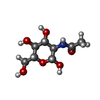
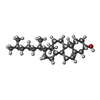


| #1: Protein | Mass: 81574.406 Da / Num. of mol.: 1 / Mutation: F77A, N295A Source method: isolated from a genetically manipulated source Source: (gene. exp.)  Homo sapiens (human) / Production host: Homo sapiens (human) / Production host:  |
|---|---|
| #2: Protein/peptide | Mass: 1004.185 Da / Num. of mol.: 1 / Source method: obtained synthetically Details: This peptide Sar1-AngII is the ligand of the protein angiotensin receptor. Source: (synth.)  Homo sapiens (human) Homo sapiens (human) |
| #6: Sugar | ChemComp-NAG / |
| #7: Chemical | ChemComp-CLR / |
-Details
| Has ligand of interest | Y |
|---|---|
| Has protein modification | Y |
-Experimental details
-Experiment
| Experiment | Method: ELECTRON MICROSCOPY |
|---|---|
| EM experiment | Aggregation state: PARTICLE / 3D reconstruction method: single particle reconstruction |
- Sample preparation
Sample preparation
| Component | Name: Angiotensin receptor AT1R in complex with Gq proteins and Sar1-AngII Type: COMPLEX / Entity ID: #1-#5 / Source: RECOMBINANT |
|---|---|
| Molecular weight | Value: 0.168 MDa / Experimental value: YES |
| Source (natural) | Organism:  Homo sapiens (human) Homo sapiens (human) |
| Source (recombinant) | Organism:  |
| Buffer solution | pH: 7.5 |
| Specimen | Embedding applied: NO / Shadowing applied: NO / Staining applied: NO / Vitrification applied: YES |
| Vitrification | Cryogen name: ETHANE |
- Electron microscopy imaging
Electron microscopy imaging
| Experimental equipment |  Model: Titan Krios / Image courtesy: FEI Company |
|---|---|
| Microscopy | Model: FEI TITAN KRIOS |
| Electron gun | Electron source:  FIELD EMISSION GUN / Accelerating voltage: 300 kV / Illumination mode: OTHER FIELD EMISSION GUN / Accelerating voltage: 300 kV / Illumination mode: OTHER |
| Electron lens | Mode: BRIGHT FIELD |
| Image recording | Electron dose: 64 e/Å2 / Film or detector model: GATAN K2 BASE (4k x 4k) |
- Processing
Processing
| Software | Name: PHENIX / Version: 1.19.2_4158: / Classification: refinement | ||||||||||||||||||||||||
|---|---|---|---|---|---|---|---|---|---|---|---|---|---|---|---|---|---|---|---|---|---|---|---|---|---|
| EM software | Name: PHENIX / Category: model refinement | ||||||||||||||||||||||||
| CTF correction | Type: PHASE FLIPPING AND AMPLITUDE CORRECTION | ||||||||||||||||||||||||
| 3D reconstruction | Resolution: 2.9 Å / Resolution method: FSC 0.143 CUT-OFF / Num. of particles: 2380323 / Symmetry type: POINT | ||||||||||||||||||||||||
| Refine LS restraints |
|
 Movie
Movie Controller
Controller


 PDBj
PDBj
